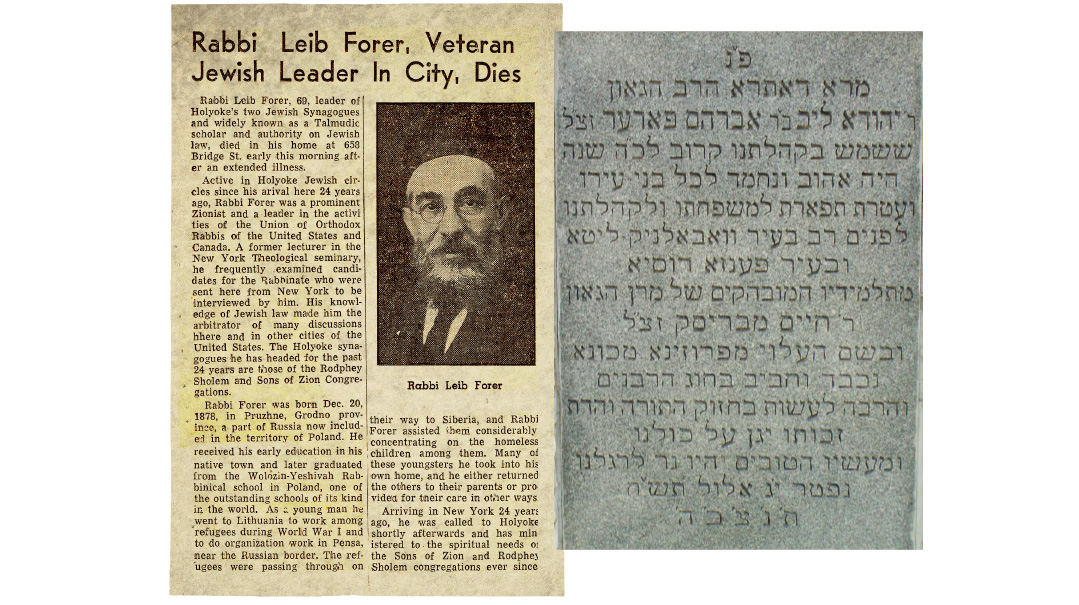The Holy Man of Holyoke
| March 8, 2022"The great gaon, Sar haTorah and otzar of yirah, Rav Yehuda Leib Forer, chief rabbi of Holyoke, Massachusetts"

Title: The Holy Man of Holyoke
Location: Holyoke, Massachusetts
Document: Newspaper clipping
Time: 1948
In the fall of 1948, a package arrived in Holyoke, Massachusetts, the center of the US paper industry, from besieged Jerusalem. The package contained the newly published sefer Avi Ezri, sent by its author, Rav Elazar Menachem Shach. Two weeks later Rav Shach wrote a follow-up letter, addressed to “my rebbi, the great gaon, Sar haTorah and otzar of yirah, Rav Yehuda Leib Forer, chief rabbi of Holyoke, Massachusetts.”
Rav Shach elaborated in his letter on why it was important to him that Rav Forer receive a copy. “The Rav’s imprint is felt in my sefer, as I recall the shiurim on Maseches Nedarim that you delivered in Vabolnik during World War I….” Unbeknownst to the sender, the addressee had passed away several weeks earlier, and wouldn’t merit to reap nachas from his talmid’s accomplishments.
Rav Yehuda Leib Forer (c. 1878–1948) was born in Pruzhan, where Rav Elya Feinstein served as rabbi. As a 12-year-old, young Yehuda Leib went to Volozhin, then Telz, where he was a student of Rav Shimon Shkop. Proceeding to Brisk, he soon emerged as one of the premier students of Rav Chaim Brisker. His chavrusa there was the genius of the yeshivah world, Rav Shlomo Poliachek (the Meitscheter Illui).
Rav Shimon Shkop arranged Rav Yehuda Leib’s shidduch with Menucha Musha, the daughter of Rav Dovid Benzion Gefen, rav of Vabolnik. Rav Forer eventually succeeded his father-in-law as rabbi, and during World War I established an informal chaburah for stranded yeshivah students, of which Vabolnik native Rav Elazar Menachem Shach was a member.
When speaking of Rav Leibskeh, Rav Shach would say: “Such an amazing love of Torah doesn’t exist anymore. Whenever he came to Slabodka, he’d go straight into the beis medrash, and before greeting anyone, he’d start discussing Torah with one of the students, in whatever subject he was studying. Everyone in Slabodka talked about Reb Leib’s burning passion for the Torah. It made a strong impact on me, which I feel to this day.”
With his next rabbinical position at Penze under Bolshevik control, he immigrated to the United States in 1924, accepting a rabbinical position in Holyoke. He remained in Holyoke until his passing, but also had stints delivering shiurim in RIETS and Chaim Berlin. Students from Chaim Berlin and Chofetz Chaim (RSA) would travel to Holyoke to obtain semichah from him. One of his talmidim at Chaim Berlin was the future rosh yeshivah of Ner Israel, Rav Shmuel Yaakov Weinberg, whose father-in-law Rav Yaakov Yitzchak Ruderman would describe Rav Forer as “one of the quickest minds he had ever met.”
Rav Yosef Dov Soloveitchik enjoyed a close relationship with the Holyoke Rav, who helped him obtain his position in Boston in 1932 after receiving the following letter from Rav Moshe Soloveitchik (who was the son-in-law of his childhood rav, Rav Elya Pruzhaner):
Last Friday I sent you the chiddushei Torah of my son the gaon; I’m certain that you have received them. Now I’m writing about the matter that is known to you, and I am including a check to cover the costs of your trip. I would like you to go there. I don’t mean to trouble you for my or my son’s good, but rather for the matter itself, for this will bring honor to all of Israel. Who more than my son the gaon is suitable for this?
New England Compatriots
Rav Forer’s arrival in New England helped usher in the “golden age” of the New England rabbinate. In addition to Rav Soloveitchik and Rav Forer, some other rabbanim included Rav Eliezer Silver (Springfield), Rav Yehuda Levenberg (New Haven), Rav Pinchos Dovid Horowitz (the Bostoner Rebbe), Rav Avraham Lipschitz (Fall River), Rav Moshe Don Sheinkopf (Waterbury-Springfield), Rav Ephraim Pelcovitz (Bridgeport), and Rav Yehoshua Klavan (Burlington, Vermont).
Massachusetts Mentor
Rav Mordechai Gifter “discovered” Rav Forer while serving as a rav in Waterbury, Connecticut, in the early 1940s. When he had an important question or just wanted to speak with someone of stature in learning, he would travel to Holyoke to spend time with the great Torah sage. Some of their (often lively) correspondence was compiled into a sefer entitled Mili DeIgros (Vol I).
(Originally featured in Mishpacha, Issue 902)
Oops! We could not locate your form.





